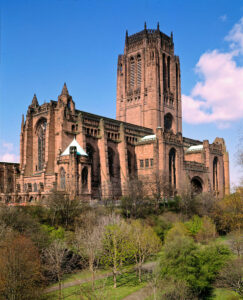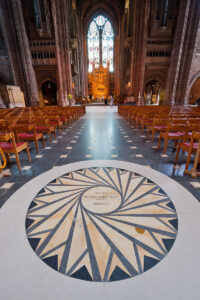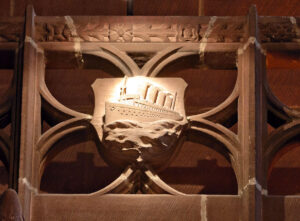Canon Val Jackson of Liverpool Cathedral – Friday 10th December 2021
A well-attended meeting of the Society on 10th December 2021 heard Canon Val Jackson talk about her supervision of the archives of the Anglican Cathedral, which began in a small room in a vaulting turret, and how she has since collated, exhibited and otherwise publicised this varied collection. Luckily an early Dean of the Cathedral had a secretary who had the necessary virtue – from an archive point of view – of hoarding papers and photographs and all sorts of other items.

The building of the cathedral, which began in the first decade of the twentieth century led to a daily correspondence between the team working on site in Liverpool and the architects (G.G. Scott and his “mentor” Bodley) in London. An early Dean, Frederick Dwelly, maintained contact with the internees at Huyton in World War II and the resulting correspondence has survived. Photographs too have been digitised and catalogued and put into non-acid storage folders, so they will be preserved and can be used by students and other researchers. The King’s Liverpool Regiment and the Pals formed by the regiment have given rise to a magnificent roll of honour. The remarkable Chavasse family, which provided the second Bishop of Liverpool, Francis, also included two pairs of twins, one pair male, the other pair female: the latter pair both lived over a hundred years. Memorabilia on individual servicemen and women are also collected. Donations are regularly added to the collections. (Now I know what to do with my photograph of my grandfather in his King’s Liverpool Regiment kilt and shall donate it, as his only living descendant).

A delightful story was of King George V coming to sign a document, and a piece of stale bread being in readiness for removing any error in the signature (the bread proved to be unnecessary). The cathedral was built by many hands and descendants of the masons and workmen often come to visit, sometimes providing further insights into the process of building. Exhibitions – which are facilitated by the collections of archives – have covered such topics as the Blitz, the Battle of the Atlantic, the Centenary of the Lady Chapel, Titanic 2012, and the King’s Liverpool Regiment in World War One. Various groups concerned with archives maintain contact, supporting the efforts of Canon Jackson and her team. These include Hope University and the National Archives, which underlines the importance of the archives. A memorial to nurses turns out to include many from Wales and other places, as well as Liverpool itself. The archives, like other aspects of the Cathedral, are supported by the Friends of Liverpool Cathedral. It was interesting to learn that the stone used at the West End of the Cathedral at the building’s completion is inferior in quality to the Woolton stone used in the rest of the Cathedral. It was also interesting to learn that the inventory of the Cathedral silver runs to two hundred pages, and that Edward Carter Preston, who produced a series of iconic sculptures for the Cathedral also designed commemorative medals for World War 1.

Val delivered a fascinating account of rare archive treasures, which has encouraged those present to discover more about their historical origins.
John Cowell
All images: © Ron Jones.